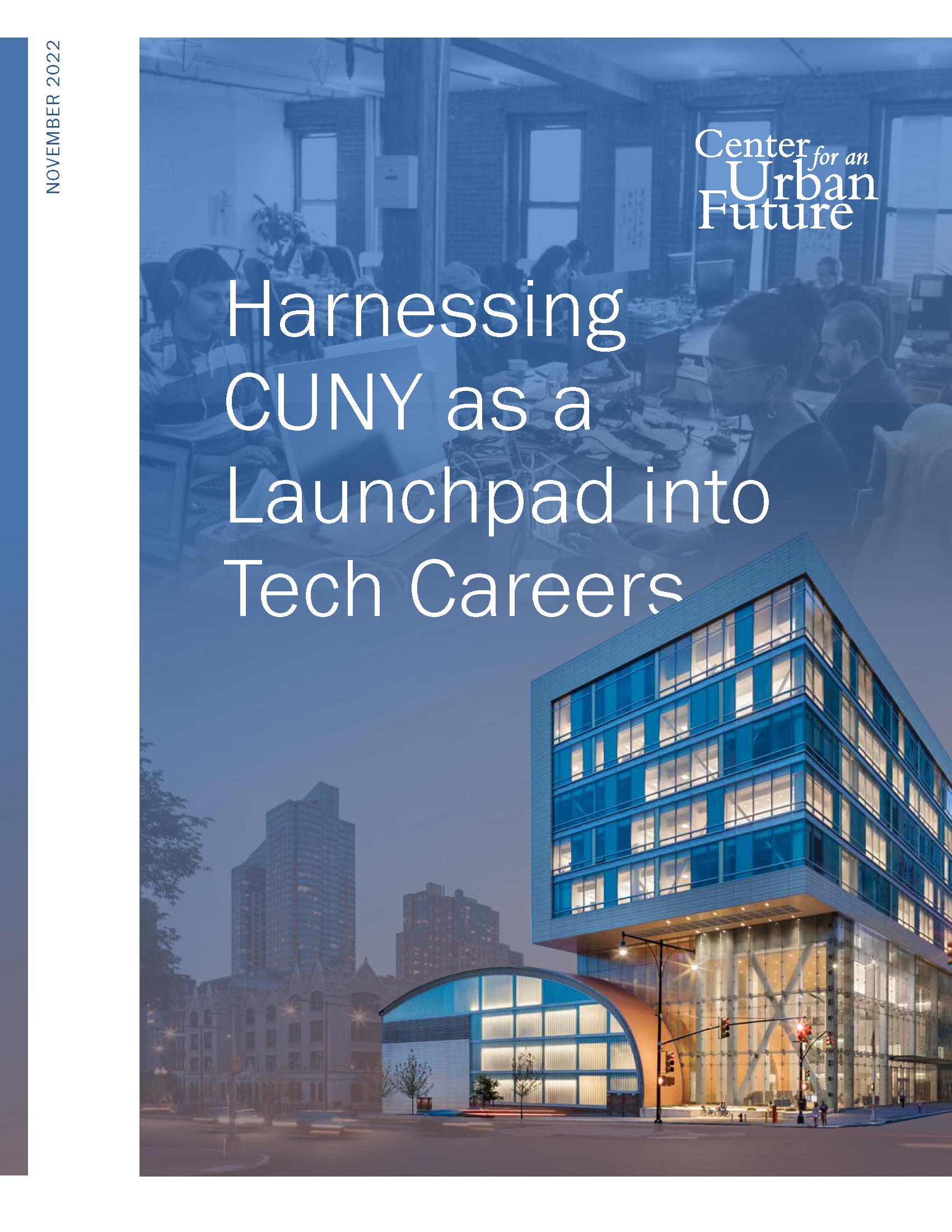For New York City and State policymakers intent on supporting policies and investments that expand economic opportunity, few areas offer more promise than developing stronger transfer pathways at CUNY. By supporting a better transfer experience, policymakers can help ensure that thousands more students who begin at a CUNY community college—most of whom come from lower-income households—are able to earn a bachelor’s degree and get on the path to a well-paying career.
Already, CUNY has taken several steps to improve the transfer experience—and committed to further gains in the university’s 2023-2030 Strategic Roadmap. To accelerate and cement these gains, however, New York City and state elected officials will need to double down on support for what’s working at CUNY. At the same time, CUNY must strengthen internal efforts to improve faulty systems and focus on delivering better outcomes for transfer students.
For city and state leaders: Prioritize improving the transfer experience at CUNY—and invest in programs that deliver better outcomes.
- Launch the CUNY Transfer Accelerator to invest in evidence-based initiatives that are boosting transfer student outcomes. While CUNY has made important progress in recent years on recognizing the problems with the transfer process and identifying opportunities for improvement, these innovations have only begun to roll out across CUNY’s 20 undergraduate colleges. To change this, Mayor Adams and the NYC Council should consolidate support for improvements in CUNY’s transfer process by launching a new CUNY Transfer Accelerator initiative. This initiative would invest up to $5 million in operationalizing and scaling up the effective practices identified through CUNY’s A2B program and across this report—from expanding and marketing the T-Rex tool and replicating the Articulation of Credit Transfer (ACT) initiative across the rest of the CUNY system, to seeding new Transfer Affinity Group and Business Academy models at the colleges that lack them today.
- Create a new CUNY Flex program to provide success-boosting wraparound supports to transfer students, part-time students, and adult learners. CUNY’s flagship college success programs—CUNY ASAP for community college students and CUNY ACE for senior college students—have proven highly effective at boosting graduation rates. But transfer students can struggle to access these programs. Both programs require full-time enrollment, and transfer students seeking to access CUNY ACE must agree to graduate within four semesters or risk losing eligibility. For the many transfer students who need to enroll part-time in order to juggle family and work responsibilities, these programs are not an option. Mayor Adams and the City Council should help address this gap by launching a new CUNY Flex program, which would adapt the evidence-based supports provided through CUNY ASAP for part-time students, with a focus on transfer students and adult learners.
- Scale up CUNY ACE and SEEK to serve more students who transfer into senior colleges. One of the core challenges facing many of CUNY’s aspiring transfer students is the loss of supports experienced when students move from community college to senior college. This is most evident in the wildly differing scales between two of CUNY’s highly effective college success programs, CUNY ASAP and CUNY ACE. While ASAP serves nearly a quarter of all community college students, the comparable ACE program only has the funding to serve about 3 percent of CUNY’s senior college students. Similar capacity gaps exist between the community college-based College Discovery program and the senior college-based SEEK program. To help mitigate the challenge of transfer shock and significantly boost graduation rates for transfer students, city and state leaders should work with CUNY to scale these opportunity programs so that CUNY’s four-year colleges are able to offer the same level of support as its community colleges do today. By growing CUNY ACE to serve a similar share of all students as CUNY ASAP, city and state policymakers can boost graduation rates by 40 percent or more—and help ensure that far more than the current figure of one in nine community college students who enroll with plans to transfer to a four-year program is able to earn a bachelor's degree within six years.
- Revise the CUNY funding formula to incentivize successful transfer outcomes. As the largest funders of CUNY, the city (for community colleges) and state (for senior colleges) have significant leverage over how CUNY operates. City and state officials could make a share of funds conditional on successful transfers—including the number or share of credits counted toward the degree at the destination college and academic performance following a student’s transfer. In doing so, they would provide a powerful incentive toward greater cooperation and best practices such as joint advisement, developing stronger and more interoperable data systems, and hiring more advisors. Allocating additional funding to CUNY colleges for improving outcomes among transfer students can help incentivize further reforms; offset some of the costs that are associated with increased graduation rates, like expanding advising services; and reward CUNY for helping students save money as they make progress toward earning a degree.
For CUNY: Make every college a champion of transfer student success
- Launch a Transfer Success team at each college, with the goal of replicating and systematizing recent initiatives that have shown the most promise. In recent years, a small number of initiatives at CUNY have started to deliver meaningful results in improving the transfer experience, but these initiatives are mostly small and limited to a handful of campuses. To help facilitate the sharing of best practices and implementation of these models across the system, CUNY should launch a Transfer Success team at each college. Comprised of researchers, faculty, administrators, and peer mentors drawn from the campus community, these teams should help align on-campus efforts with the resources and strategy at CUNY Central, and work to embed programs and approaches like the Articulation of Credit Transfer and Transfer Affinity Group models at every college.
- To ensure the success of CUNY’s Strategic Roadmap commitment, CUNY should set and publicly report out system- and college-level goals for transfer outcomes. Without more accurate and consistent data on transfer student outcomes, it will be difficult for CUNY to make the system-wide progress that’s needed. To change this, CUNY leadership should work with its Office of Institutional Research and Assessment to track and analyze more complete data on transfer outcomes by college and across the full system. This should include an overall rate for completing bachelor’s degrees within three years of transfer, with specific progress targets to be negotiated with each senior college. Other measures should include goals around average number or percentage of credits successfully transferred at senior colleges, and the rate at which community college students apply to transfer within three years of beginning their studies. The annual Student Experience Survey also could include a set of transfer-specific questions to measure the satisfaction of pre-transfer and transfer students at each campus.
- Create a Transfer Academy to train faculty and administrators to become knowledgeable advocates for better transfer pathways. Recent research has found widespread knowledge gaps around transfer policy and practices among CUNY faculty and administrators—gaps that may be inadvertently harming aspiring transfer students and contributing to poor outcomes. To tackle these shortcomings, CUNY should launch a Transfer Academy—a professional development initiative focused on training faculty and administrators to become champions of a better transfer experience—and recruit peer mentors, advisors, and nonprofit partners to serve as resources for college faculty and staff.








